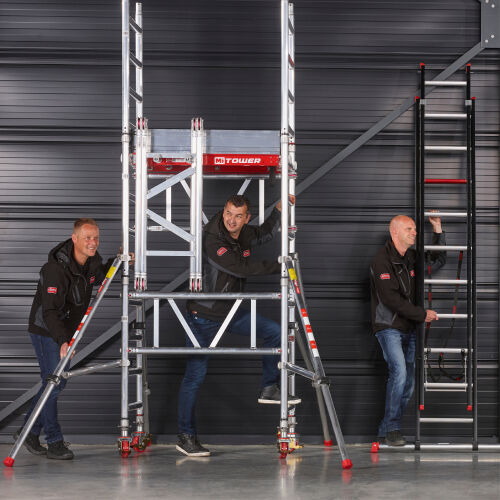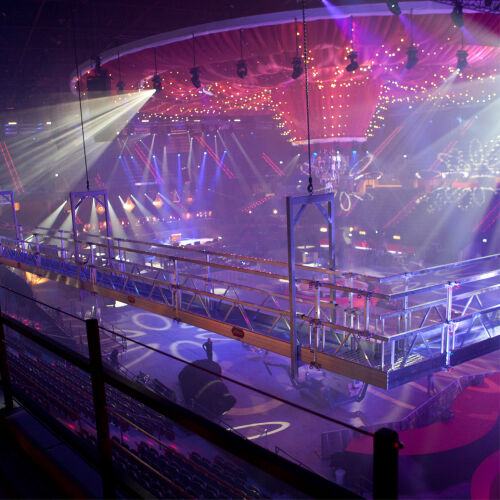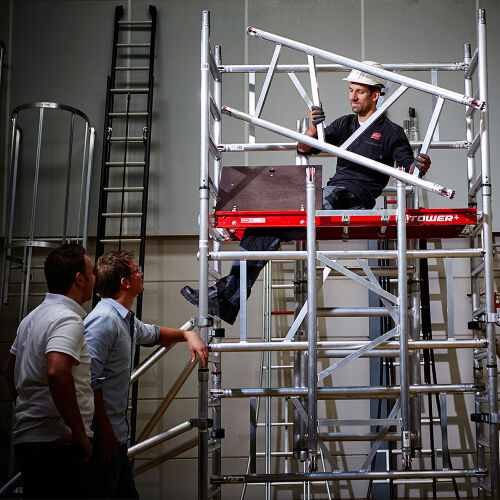What are the components of a rolling tower?
Scaffolding, folding towers, quick assembly towers, rolling towers — these are all often-heard names for our scaffolds. We actually refer to the same thing, regardless which name we use for it. In principle, scaffold is a collective term for many different standard components. Without a frame, guardrails and platforms you cannot build a scaffold. This blog explains the various terms and describes the function of the various scaffold components.
Frame
A frame consists of two uprights with several rungs or rung tubes in between. This gives the rolling tower its height. The choice of frames, or various frames, in the beginning determines whether the rolling tower will be built to a working height of an even or odd number of metres. After building the basic frame, you continue with two-metre frames. The collar tube is located at the top of the upright and is slightly cone-shaped so the next frame will connect and fit smoothly. A collar tube is also known as a tube coupler. Frames that are stacked one on top of the other must always be secured with a locking pin, also known as a latching bolt. The rungs — which are always equipped with anti-slip profiles at Altrex — allow you to climb easily up and down inside the frame through the platforms.
A single-width frame is 0.75 metre or 0.90 metre wide. This fits one platform. A single-width frame of 0.90 metre gives you more room and freedom, making it easier to place braces and platforms. A double-width frame is 1.35 metre wide, which fits two platforms. All three versions are available as a one-metre (4-rung) frame or a two-metre frame with seven rungs. In addition to the standard measurements, it is also possible to choose a frame with two, three or five rungs. With a MiTOWER frame you have a choice between two or four rungs.
Wheels
There is a reason why Altrex scaffolds are usually called rolling towers, because of the wheels under the basic frame. Wheels for rolling towers are available in various sizes with a minimum diameter of 125 millimetres and a maximum diameter of 200 millimetres. That way you always have a suitable wheel and an even more suitable basis for your tower.
A tower wheel consists of a wheel leg—which consists of a spindle, swivel and a circlip—and a double brake pedal. The wheel leg ensures that the wheel fits properly in the frame and creates stability during the use of the rolling tower. The spindle allows you to adjust the height of the wheel leg, allowing you to level the tower and compensate for unevenness of the ground. The swivel of a tower in the RS TOWER 5 series can be raised up to 28 centimetres. The wheels of a tower in the RS TOWER 4 series can be raised up to 18 centimetres. Adjusting the tower wheels should not be used to increase the height of the tower. Always activate the brake of the wheel during usage.
Braces
In the past, scaffolds had many different types of braces, such as horizontal braces and diagonal braces. These were the bonding elements for building the scaffold to the desired working height. Nowadays, braces are mostly used in the basic section or as knee and hip rails. The reason for this change is that as of 1 January 2018 (in the Netherlands), it has become mandatory to place guardrails before accessing a platform and regular braces are less suitable for this purpose. Horizontal braces are only used now on both sides of the basic section under the first rung of the vertical upright. You should place the braces on the inside in order to prevent the frames from bending and place the assembled basis on its wheels. The diagonal braces are placed one over the other like a cross. In the new rolling towers, most of the braces have been replaced by the Safe-Quick® GuardRails. These serve the same purpose and are even safer because it provides a rail around the worker at every height.
A brace has claws on both sides with a pawl and a spring, making it easy to connect the brace to an upright or a rung. Diagonal braces are longer than horizontal braces and at Altrex they are recognisable by the unique black coating of the pawls. In the RS TOWER 5 series, the pawls of the horizontal braces are red while the diagonal braces have red braces. In the RS TOWER 4 series, the pawls and the braces are uncoated.
Guardrails
Guardrails come in all shapes and sizes. Since 2018, it is mandatory to have a hip guardrail when accessing a platform in order to minimise the risk of falling. In the past, a guardrail consisted of two horizontal braces. Now, the Safe-Quick® GuardRail system offers a safer and easier solution. This system offers all-round protection. Guardrails combined with braces are still frequently used at the highest platform of scaffolds. These provide guardrails at knee and hip level.
The Safe-Quick® GuardRail system consist of a series of rails and braces combined into one system, making it practically impossible to assemble your scaffold incorrectly. Thanks to the arms at the bottom, the Safe-Quick® GuardRail can be placed easily high up in the rolling tower. In addition, this system has fewer loose parts making assembly much easier. The Safe-Quick® GuardRails are available in three different lengths: 1.85m, 2.45m and 3.05m.
At Altrex, we of course call this guardrail system Safe-Quick®, but other common names for guardrails are guardrail frames, racks or Quick-Safe. There are also guardrails that are used only during assembly and are ultimately replaced with traditional braces. However, we recommend a safer and more ergonomic assembly with a permanent guardrail, the Safe-Quick® GuardRail.
Triangular stabilisers
Triangular stabilisers are very important for the stability of the rolling tower. The name sort of gives away their purpose. In case of strong gusts of wind or other turbulent weather, the rolling tower might encounter a horizontal force. The triangular stabilisers keep the rolling tower in place with a wind force of up to 5 Bft. With a wind force of 6 Bft or more you must immediately disassemble the rolling tower or secure it to the façade.
A freestanding tower requires four triangular stabilisers around the tower. When the tower is used along a façade, is assembled with Safe-Quick® and is maximum 15 centimetres from the façade, then three triangular stabilisers are sufficient. Altrex triangular stabilisers for an RS TOWER 5 have a sticker with a warning function. This ensures extra safety and that you always know how far the stabiliser may be extended.
Platforms
The platforms in a scaffold serve as a rest landing or as a working floor. In general, the top platform is used for working, while the other platforms serve as rest landings or intermediate landings. You place a platform by placing the hooks on the rungs of the frame. This is easily done by grabbing the crossbeams at the bottom and lifting the platform above your head. After placing the platform, you can climb up through the inside of the frame and access the platform through the hatch. If you have a double-width rolling tower, you should always place two platforms at the desired standing/working height, in which case only one of the two platforms needs a hatch.
A platform must be secured against getting wind-blown on the short sides. We have developed a special wind security system for our platforms. In the RS TOWER 5 series, the platforms are recognisable by the red hooks and are available in a width of 0.75 metre and a length of 1.85m, 2.45m or 3.05m. We offer two types of platforms: wooden and lightweight Fiber-Deck®.
Toe boards
On the top platforms, which function as work floors, it is mandatory to place raised edges to prevent equipment and other materials from falling down. This also helps you to know where the edge of the platform is while working, so that you don’t accidentally loose your footing. Altrex aluminium toe boards are delivered in foldable sets and are at least fifteen centimetres high. The wooden toe boards need to be secured in toe board holders, which can be secured to the frame in all corners of the platform. The toe boards are available in the same dimensions as the platforms.
Maybe you will find this interesting as well!
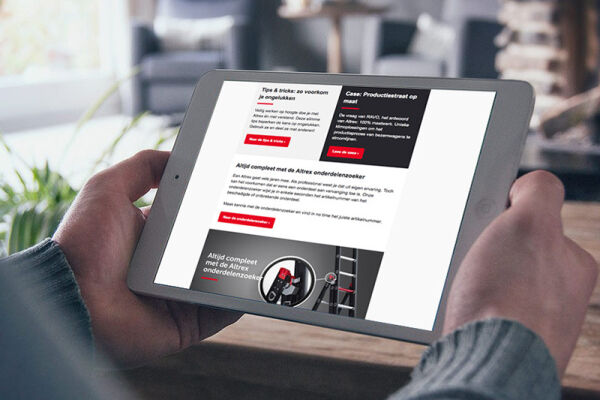
Would you like to receive more hints and tips?
Subscribe now to the Altrex newsletter to stay up to date on the latest developments and innovations, and you'll be first to receive the latest news.
Related articles
Which is best for you; a platform lift, or a passenger lift? We explain it to you here!

For every job an Altrex. But which ladder do you choose from such a wide range? We compare two of them side by side
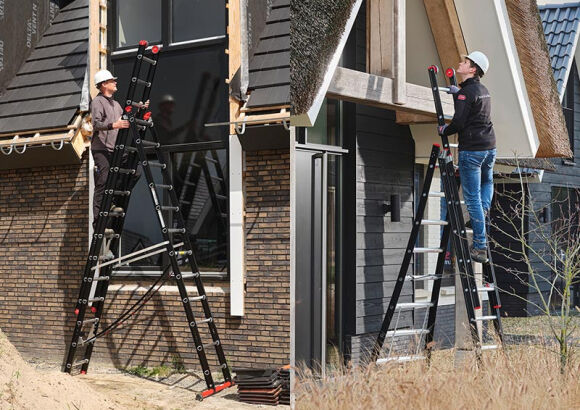
Each project requires an appropriate solution. The RS TOWER 5 Series Modular Scaffolding System gives you the

If you work at heights, then you go for safety and quality. That's why you choose Altrex mobile rolling towers. From a


